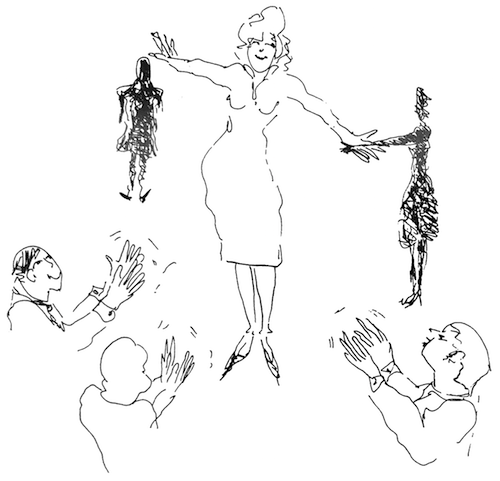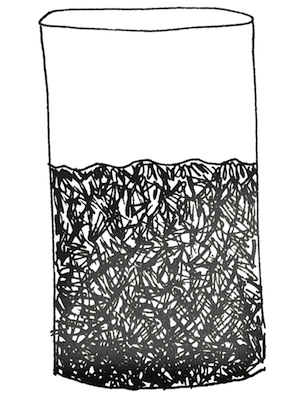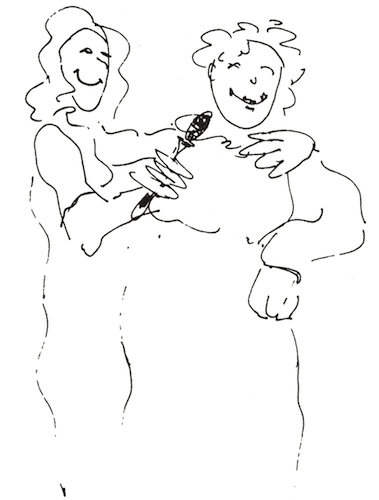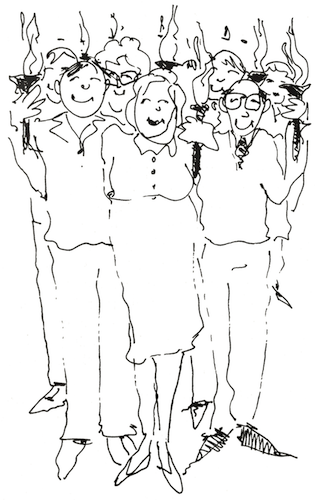23. The Later Years
Successful living in the later years begins with a process of transition, saying good-bye to what was, in order to say hello to what will be. Among the big events that herald the beginning of the later years are menopause and retirement. These are concrete manifestations that cannot be denied.
The energy released by these endings can be put to new uses when we are ready to do so. For example, when a woman has achieved menopause, she no longer has to worry about pregnancy and can enter into sex with new abandon. Likewise, not having to go to work every day frees that time to be used for something else. This is all quite logical. However, to make this happen freely, one must go through the steps of transition. Going through the transition process is always unsettling in the sense that we are making changes; a plan helps provide the structure.
The following five steps will help you to complete transition and create a new foundation for living in your later years.
Acknowledge that an end has occurred. This means you are facing a reality: “It is true. I am retired.”
Grieve the loss. This means putting words to the feelings about the loss, the resentments, fear, and rejection.
Acknowledge the positive parts of that which has just ended. This means to honor your experience by openly appreciating what you got from it. Very few things are entirely bad.
Notice and acknowledge that your life now has spaces open to be filled with new possibilities. By the time you have finished this step, you will probably be feeling more balanced and centered.
Now you are ready to welcome new possibilities. Take action. Center yourself, focus your energy, create what you want, and move on. Go forward with your life.
Put on your explorer’s hat and ready yourself to make another of life’s journeys. As on previous journeys, you will look for the meaning that fits your life now. Thinking about it, you realize you have done this many times before. Going to school for the first time, menstruating or shaving for the first time were such journeys. They were landmarks after which life had different possibilities. You came through with new learnings and, consequently, you came to a different place in your life. The same will be true now. However, this time you may be more conscious of the steps involved.
Going through transition is often intimidating and produces anxiety. Give yourself time and patience. Increase your level of awareness, and strengthen your resolve. Don’t hurry. Each transition develops its own rhythms. Sometimes it may take a year or more to complete all the steps. Arriving there, you will feel ready to take on new challenges.
To give energy to your transition process, give some transition parties from time to time. Pick something you are ready to say good-bye to and then something you want to say hello to. Develop a loss-gain ritual. Invite your friends who may be involved in the same process. You can support each other and have fun at the same time. Each transition must be wrestled with if your subsequent years are to be successful.
I have noticed that when people do not go through an appropriate transition, they can’t seem to focus on a new

start. Their energy and attention still seem directed toward the past, which leaves little for the present. This may result in a feeling of enduring life rather than enjoying it. It also creates a feeling of depression, which is exacerbated by negative images and fantasies of what living in the later years will be like.
A composite of commonly held negative pictures of the later years goes something like this: “When I am old, I will no longer be interested in or capable of sexual satisfaction. I will become physically feeble, unsteady, and perhaps hard of hearing or have difficulties in seeing. I will be sick because old age and sickness go together. My brain will deteriorate; I will be intellectually dull. I will be unattractive, wrinkled, and fat. I will annoy people with my neediness, my complaining, or withdrawal. I will have to relegate myself to TV soap operas and busy myself with make-do work. I expect to be lonely and rejected. After all, who wants an old person like me around anyway?
“I will sit in a rocking chair, gazing vacantly out the window, muttering to myself, ignoring my surroundings, and looking stupid. I will feel defeated, dependent, and useless. Everything that is important for me will have already happened. I will resign myself to waiting for the ultimate end, death.”
If I thought this was the fate that awaited me in my later years, I would do anything and everything to avoid it, even if it killed me. I am over seventy as I write this book. In many ways, I feel my life is just starting. For people who really believe the gruesome picture sketched above, getting older must hold terrible dread. Many handle these paralyzing fears by valiantly trying to ignore and deny the signs of aging.
This just adds to the self-increasing tension and develops strong self-hatred which, in turn, makes one vulnerable to disease, depression, and unhappiness. Our selves do not like to be put down; they fight back. The self wants to grow older gracefully and be loved unconditionally during the process. We are made to be healthy at any age.
Another kind of fantasy comes from people who are caught up in the drudgery of their day-to-day work. They live for the day when they will retire. Then, as in fairy tales, their dreams will come true. They will not have to work. There will be no ticking clocks and no unreasonable bosses to deal with. They will be able to do what they please. Life will be wonderful.
People with these fantasies who did not develop the skills they needed to enjoy retirement may soon find that retirement becomes a nightmare. Harry worked hard all his life, pushing and shoving to get ahead. He prepared for retirement by buying and outfitting a trailer in deluxe style so he could be his own boss and travel wherever he wished. He was determined to be a free man. Selling the house over his wife Ellen’s objections, he reassured her that all would be wonderful. In the end, she unhappily resigned herself to those assurances.
With their house sold and their trailer ready, Harry and Ellen set off for his nirvana the day after his retirement party. Within two months of living in such a confined space, they were not speaking to each other. Within six months, Harry became terminally ill; by year’s end, he was dead.
Actually, Harry was a dictatorial man who wanted everything his way. He had few skills for congruent communication, little patience, and very low self-esteem. He made no allowance for the important and necessary transition between the life he had lived and what was ahead. The outcome was ghoulish. During his illness, Ellen refused to take care of him. When he died, her anger was still so great that she did not go to his funeral.
His plan might have worked had he and Ellen planned this new stage in their lives together. They then would have consciously and realistically prepared for this very different way of being together. After years of spending only one waking hour together in the morning and two in the evening, they now were together twenty-four hours a day. From a spacious three-bedroom house which included a workroom for each, they now were in a space about the size of one medium-sized room. It takes a lot of self-worth, a very special relationship, and lots of humor to be happy under these circumstances. They asked the impossible of each other.
Given their available resources, what else might have been possible? What if Harry or Ellen had experimented with life in a trailer for a month to find out what that kind of living was like? They could have kept their home meanwhile and continued to have options.
They might have become aware that the two of them were not ready for this drastic step; they might have made other plans. Or, they might have found out what they needed to live in this new way and taken time to learn it.
The experience of Ellen and Harry points to the need for keeping options open and carefully considering any radical change in lifestyle. To have happy and productive experiences in later years, it is important to let yourself know clearly what your pictures and fantasies really are. These pictures have a strong influence on your adjustment. Knowing them consciously enables you to deal with them and compare them with reality as you know it. These pictures are sources of thought, and thought is powerful.
Let yourself really know these fantasies. Paint them, write them down, tell them to a friend, share them with your partner, or record them on tape and then listen back. You can be sure that if

these fantasies are negative, they will become the inner voices that will inhibit and prohibit you from having what you want.
If your images are positive, they will support you and cheer you on when you get discouraged. Negative pictures rattle around inside of you, affecting you without your knowing it. We need to give these fantasies an airing.
Until we let them out, some fantasies are not even apparent to us. We may not know we have them. If you have never let yourself be conscious of your fantasies, let them emerge now. Ask yourself, “What will it be like when I. . . ?” and simply see what comes to mind.
Interesting, positive effects may follow. As you listen to your fantasies, consult your inner wisdom and ask yourself if you believe what you are saying. You may find that even other parts of you think you may be talking nonsense. That is one of the concrete benefits of giving a voice to your fantasies.
The following questions may help you find the source of these fantasies. As you consider these questions, you may even loosen your attachment to certain images or ideas and free yourself to evaluate them in the light of reason, common sense, and your present desires.
Who have you known who was old?
What was the nature of your relationship to that person?
What did you hear from and observe about that person?
What were you told about what it is like to be old?
How did you imagine yourself being when you reached
your later years?
Now check out your information against current facts and feelings.
Through researching the process of aging in healthy people, we now know that we are not doomed to decrepitude, disease, and degeneration simply because of our age. Those are outcomes of illness, not of age.
As people move into later life, they will, of course, experience physiological changes. That is life manifesting itself.
John W. Rowe, M.D., a professor of medicine at Harvard Medical School, states that “the person who ages successfully has a life style, an economic status, and personality that enhance, rather than impair, his or her ability to cope with the few changes that do accompany age” (in Robert Henig, “Aging Successfully,”AARP News Bulletin, Jan. 1988).
A separate article, coauthored by Dr. Robert Kahn, states that “Within the category of normal aging, a distinction can be made between usual aging . . . and successful aging.”
This fits in with my clinical experience. The foundation of anyone’s ability to cope successfully is high self-esteem. If you don’t already have it, you can always develop it. The aging experience is an individual affair. As in former changes, successful outcomes rest almost totally on the creative coping that comes from someone with high self-esteem. The negative picture I drew earlier is more likely to be rooted in low self-worth than in age. Age has little to do with our unsatisfying interactions with others, our dissatisfaction with ourselves and our work, or the way we dishonor life, which includes our own and that of the universe. We can learn anew at any age how to love ourselves (have high self-esteem), develop satisfying relationships, find work and other activities that are enriching, and honor life and the universe. Learning will go a long way not only to relieve pain and troubles, but also to open doors to a more wonderful life.
I keep coming back to my old allies, high self-worth and congruent communication. For most of us, learning these skills is a life-long process. I repeat, our skills and attitudes are all learned. Our limitations lie in our resistance to learning something new. For many, change is a scary process. Some people immobilize themselves with the adage that you can’t teach an old dog new tricks. It is hard for them to grasp that our brains continue to function throughout our lives.
We now have reliable information that challenges the negative assumptions of the past. Research findings on the aging process of healthy people show the following:
Our capacity to learn increases as we age. The mind continues to grow when it is stimulated.
The capacity for sexual excitement and satisfaction continues and, under some conditions, increases. We don’t lose our sexual interest just because we are older.
The body demonstrates great regenerative power when it teams up with high self-esteem, purposeful activity, physical movement, and satisfying love relationships. It is living tissue, and it responds well to good care.
The big challenge for the later years is to act on what we know about health. Acquaint yourself with research findings on aging and trade in any negative pictures for some positive, exciting ones. A new picture based on health would be something like this: “When I am older, I expect to be healthy. I will be wiser. Having time and interest, I will create stimulation to enjoy my life. I will experiment with new things.
“I will be able to enjoy myself alone. I will also continue being able to connect with other people when I choose.
“I will be physically active. I will wear beautiful colors. My body will be supple and good looking.
“I will have energy. I will shine from the reflection of myself.”
The challenge now is: What do I have to learn to accomplish this? Please remember your thoughts, attitudes, and perceptions have great power. Seeing a glass filled halfway, you can describe it as being half full, which will direct your energy upward and will give you positive feelings. Or you can see it as half empty, which will send your energy downward and give you negative feelings. Both descriptions are accurate, but they bring up quite different feelings. I recommend that we picture the glass as half full.

It makes sense to look at things positively. I believe that reframing our attitudes from negative to positive creates an invitation to attract other positive energy. Smiling at someone who smiles back is an example of this.
I would like to promote the idea that one possible outcome of growing older is becoming wiser. Healthy people can be fountains of wisdom and experience and can be helpful partners to younger people and to each other. What if every community had an “Elders Council”?
I know of some exciting programs that bring older people together with young children and adolescents to form a kind of grandparent-grandchild relationship. In these days when families are so scattered, this can be a valuable opportunity for all.
One’s attitude and spirit are powerful factors in physical, emotional, and spiritual wellness at any age. Of course, the body will show signs of use and wear as we grow older: We get gray hair and our metabolism changes. Our reaction times change, and recovery from illness takes longer. But the human spirit, attitude, self-worth, and emotional responses only get better with age. These are like good wine.
Very few communities have done much to organize innovative programs based on the resources of the older person. Almost every community has Senior Citizen programs and health-care facilities, but too few have programs through which older people can contribute in a meaningful way to the community. Perhaps you, a reader of this book, might organize such a service through your church or other community facility——a program in which everyone benefits.
I have often been impressed by how quickly older people become more vital, creative, and healthy once they begin to be excited by their possibilities and decide to live their lives, rather than “dying” them. At funerals, I feel the saddest for those who really never lived.
I believe research will prove what we already know clinically: that age is a concept in our heads. Low self-worth, poor nutrition, lack of stimulation, inadequate living conditions, isolation, friendlessness, and negative relationships all contribute to making us vulnerable to physical and mental ill health. The antidote is high self-worth, good nutrition, mental and physical stimulation, attractive and healthy living conditions, satisfying connections with other people, intimate human contact, nourishing relationships, and clear purposes.
Structure is another important dimension of the later years. Retirement is new and unknown. just as in adolescence, you have not been there before. There is no one who tells you what to do. The clock and the calendar become superfluous. The 8-to-5 workday dividers are removed, and you are responsible for structuring your entire day. After outside authority has done it for so long, designing your own life is a monumental challenge. Now you have to develop a structure that is tailor-made to support you.
Retirement is a testing ground for your personal coping skills, your maturity, and the nature of your relationships. You can look at this as a wonderful opportunity to find out what you need. For instance, you can learn about your flexibility to adjust, your level of self-esteem, your triggers to low self-esteem, your entrenched habits, and the rhythm of your moods, in ways that were not apparent before.
Many people in relationships flounder seriously at this time. Not only does the new situation create a new context, but it may challenge the effectiveness of what currently exists. All your relationships come up for scrutiny. If your relationships need help, find a way to give it to them. Be your own Sherlock Holmes. Do what you need to do when you see the problem; don’t let your shyness or fear get in the way (see the chapters on self-esteem and couples). When you find you are floundering, join (or create) a self-help support group, where you can get new perspectives. Talking things out with a group of caring people is healing as well as bonding. Professional counseling also helps.
Perhaps it is becoming more clear that our context does not automatically limit our opportunities. How we operate and how we cope in that context ultimately determine what happens to us. Living in the later years is simply another context for creative living.
If you already have developed high self-esteem and congruent communication, going into your later years is another opportunity for further growth. You know that your high self-worth depends on you and not your job, your money, or your connections. You can take a positive attitude or a negative one. The image that comes to mind again is of the sculptor who approaches the rough stone. What comes out will be what he finds there, rather than any preconception.
Many people reach their later years after being outwardly successful; inwardly, though, they may carry a chronic feeling of emptiness and loneliness. Deprived of the outer trappings of success——money, authority, status, etc.——these persons often experience depression or start acting out inappropriately when they enter their later years. What
they counted on to be their strength is gone. If this is happening to you now, treat it as a discovery and look for ways to develop your self-worth. This need not be a lonely pursuit: relatively few people are brought up with high self-esteem and congruent coping skills.
Recently I gave a talk to a group of retired male executives. A man over seventy, formerly a bank president, told me, “I have no title. I have no office. I am nobody.” (Within minutes, three other men told me versions of the same thing.) From an observer’s point of view, this man really had achieved all the outward signs of success. What had yet to be developed was a sense of his inner Worth. Since these four people regarded their titles and big offices as definers of their self-worth, retirement signified being ruthlessly torn apart and lying there bleeding and helpless.

When youth and young looks fade, when money, power, and position have gone, people can suffer great agonies if they equated these factors with personal value. Until they learn other ways to live, many take the paths of alcoholism, illness, divorce, depression, or suicide. Outside help is often needed at this time to discover how life can be transformed.
People don’t have to wait until their later years to discover their inner worth. Beyond any outer evidence of success, the meaning and value of life are central to human existence. Once we can value life, we can experience our own spiritual awakening.
The first step is high self-esteem. This is an attitude we can learn at any age, and it’s especially useful in our later years. For example, learning or having high self-worth enables us to continue uncovering our untapped resources. We can finish old dreams if they still seem appealing, or invent new ones. We are limited only by our ability to dream, and the energy to make the dreams manifest.
The later years are a time when you can take on new purposes in your life, perhaps something you have always wanted to try. If the yearning is still there, try it out. If you are looking for some entirely new direction, you may want to turn back to the fantasy exercises earlier in this chapter.
Our common human needs, present at any age, are listed below to remind you of what you already know but may have forgotten momentarily.
We need to love and be loved, to be noticed, recognized,
and respected, to be literally and figuratively touched.
We need to matter and have a purpose.
We need to be stimulated and to learn new things.
We need to have satisfying and intimate relationships.
We need to have fun and humor.
We need to be economically secure.
We need to be mentally and physically healthy.
We need to belong.
We need to be part of a vital community of friends and
colleagues.
We need to be in touch with our life force, our religion, our
divinity.
These needs are present in all stages of our life, from infancy onward. We don’t always learn them as we go along. In some stages, they are more in the foreground than in others. In our later years, it is important to ask ourselves where we are on all these points and then take steps to improve and acquire what we do not yet have.
Pause for a moment now and make a mental inventory of your present lifestyle.
Are you eating nourishing foods?
Are you exercising?
Are you paying attention to your emotional needs?
Are you continuing to develop your skill of congruent
communications?
Are you having nurturing relationships?
Do you have a support group?
Are you developing your ability to listen, to be honest with
yourself, to ask for what you want?
Have you developed effective ways to handle conflict?
Are you excited about your life and enjoying it?
Are you further developing your sense of humor and having
fun with life?
Are you developing satisfying ways of loving and valuing
yourself?
Are you cultivating an interest in learning new things?
Do you have good ways to relax?
Are you allowing yourself to learn from your mistakes?
Are you giving yourself full permission to love openly and deeply?
If you have reached the later years and cannot say “yes” to these questions, it is time to begin. Forgive yourself if you haven’t learned before; your world has not been geared toward focusing on these ideas. Accomplishing these learnings will pay handsome dividends: profound positive effects on you, your health, and the way you approach the world. It is important to know that we have choices about what we want to do with our lives. We can choose to take a positive attitude or a negative one.
Make a list of the people you know personally, or have read or heard about, who have made significant contributions to their lives and the world in their later years. Learn about them. These can give you positive models for later life. Form a study group to pool your resources. We need to find positive, healthy models to counterbalance the effect of the terrible negative images from the past.
Find healthy people in their sixties or beyond. Look for them in health spas, church groups, YWCA and YMCA classes, Elder Hostels, travel clubs, square-dance groups, Senior Citizens groups, outdoor events, neighborhood organizations, and retirement associations. Notice their beauty, aliveness, and zest for living. Learn about their philosophy and their approach to life. Experience the richness and excitement of their company.
You might even get excited about interviewing some of these people, recording them on tape, and giving them a copy of your interview. We need a lot of positive exposure

to healthy people in their later years. Ugly, negative images of the older person are still quite powerful and need to be supplanted by powerfully positive, attractive images.
If you are a younger reader who has relationships with parents or other relatives in their later years, give them support. Treat them as responsible, responding human beings. Do not limit them by treating them as over the hill, pampering them, or being condescending to them. See them instead as human beings who are entering a vast arena in life that contains many unknowns and opportunities for taking new risks. Make room for the fact that they may feel anxiety, as people often do when going into new things.
I remember a family of grown-up children who brought their 84-year-old mother to me because she was showing signs of sexual interest in a “strange man” very near her age. She was “caught” sitting in the park with him. When I was able to convince the grown-up children that their mother, Anita, was acting responsibly toward her loneliness and her wish to grow, they could see her as a person: as Anita, not merely “Mother” or “Granny.” She was more like them than different, but their images had affected their thoughts, perceptions, and behavior. These children had denied their mother her personhood.
Vitality is the outcome of high self-esteem. It goes a long way toward a positive outlook which nourishes the whole self. People of high self-esteem have eyes that shine; their spirits are round and inviting. They are open, have a wonderful sense of humor, and meet life with dignity and enthusiasm. They are efficient and knowledgeable as well. All of this is created by their positive attitude, which can be cultivated at any point in life with any person who is willing.
I have already mentioned the power of your thoughts to affect your health and outlook on life. Isn’t it miraculous that a change in thinking can produce so many fine results?
Through their modeling, the older people of today are torchbearers for new images of what our older years can be. Older persons are beginning to be recognized as one of society's great pools of resources, energy, wisdom, and creativity. This is good. It is also timely: by the year 2000, 30 percent of our population will be over the age of sixty. We will need their energy. The challenge for older persons of today is to show, by their example, the magnitude of their potential contribution to their own lives, their community, and the planet.
